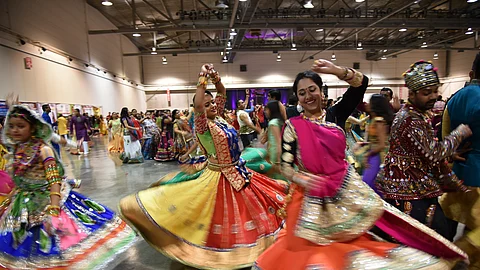
- Destinations
- Experiences
- Stay
- What's new
- Celebrating People
- Responsible Tourism
- CampaignsCampaigns
- Subscribe
- Buy Now

The famed vibrant folk dance of Gujarat, Garba, has earned a spot in UNESCO's list of Intangible Cultural Heritage. This boisterous celebration, marking the nine days of Navratri, has transcended borders and communities to become a pan-India phenomenon. Similarly, Dandiya, which involves the use of colourful sticks, has also become equally popular.
Even though the basis of all is the worship of Shakti or the divine feminine, the festival has many regional variations. At the more earthy level, it’s the Dandiya Raas that mortal beings wait for breathlessly to be performed right under the watchful eye of the goddess.
Garba, in contemporary times, is no stranger to any part of India. In fact, it has travelled to every nook and corner of this country, with considerable help from the Hindi film industry and the pan-India release of albums featuring songs specifically composed for the purpose. One of the memorable and early picturisations of Dandiya on the silver screen was the religious dance number "O! Sheronwali," in the 1979 Hindi film "Suhag," featuring Amitabh Bachchan and Rekha. It showcased the folk dance as it was originally meant to be, performed in a slow beat with dancers twirling in circles while singing praise of the goddess.
In the '90s, the Navratri-Dandiya staples became speedy and frenzied. It was the era of Navratri-Dandiya songs, primarily by Falguni Pathak, but not limited to her alone. Pathak earned the sobriquet "Dandiya Queen," and since the '90s, has remained the most popular. Bollywood also tapped the rising popularity of Dandiya in a highly successful film, "Hum Dil De Chuke Sanam" (1999), through its song "Dhol Baje."
Garba is now consumed globally by Indians abroad, aided by the strong presence of Gujarati expatriates. One of the most popular folk dances of Gujarat, hailing specifically from its Saurashtra region, Dandiya Raas takes its name from a pair of wooden sticks that the dancers use to mark time. Raas traces its origins to the legends associated with Lord Krishna. It has been a popular form of communal dance among various communities of the Saurashtra region for centuries and is performed—originally by male dancers only—at weddings, fairs and festivals.
According to Dr Utpala Desai, known for her study of the folk traditions of Gujarat, Tal Raaska and Danda Raaska (dances where time is marked with a clap and a wooden stick, respectively) find mention in the 8th-century text "Harivamsa Purana." Traditionally, it was only performed by males. Songs were often praises sung for Lord Krishna. During the course of its evolution, Raas came to have slight variations in style as performed by different communities, such as farmers, warriors, fisherfolk, etc. The Dandiya Raas performed in massive pandals (tents) do not bear much resemblance to the original Raas.
Dr Desai notes that the modern Dandiya Raas—the Bollywoodised version—is a recent creation. It is known as "Mishr Raas" or "mixed Raas," featuring both men and women. She states in a write-up on this topic on "Sahapedia": "Anecdotes suggest that this form emerged in response to the newly formed Government of Gujarat’s desire to promote Gujarati culture on Republic Day in 1961."
With almost every city and town in this country staging its own Dandiya Raas shows now, it’s no longer just socially adequate to participate, with practice classes and complete costumes and jewellery that are fairly easily available.
What’s more extraordinary is to have an authentic Dandiya Raas experience where it all began—in Gujarat. Vadodara (Baroda), Ahmedabad, Gandhi Nagar, Rajkot and Surat are the top options for the Navratri nights. In fact, some venues accommodate more than 10,000 participants each evening. The Navratri festival this year runs from October 15 to 23, giving ample time to prepare for a sensational Dandiya experience. Because when a drummer starts beating the dhol, and a Navratri special number starts streaming from a megaphone, it would be time to get drowned in an alternate reality full of melodious music and dance that is energetic and psychedelic.
Archana Khare-Ghose is a New Delhi-based journalist. She blogs at archakhareghose.com
